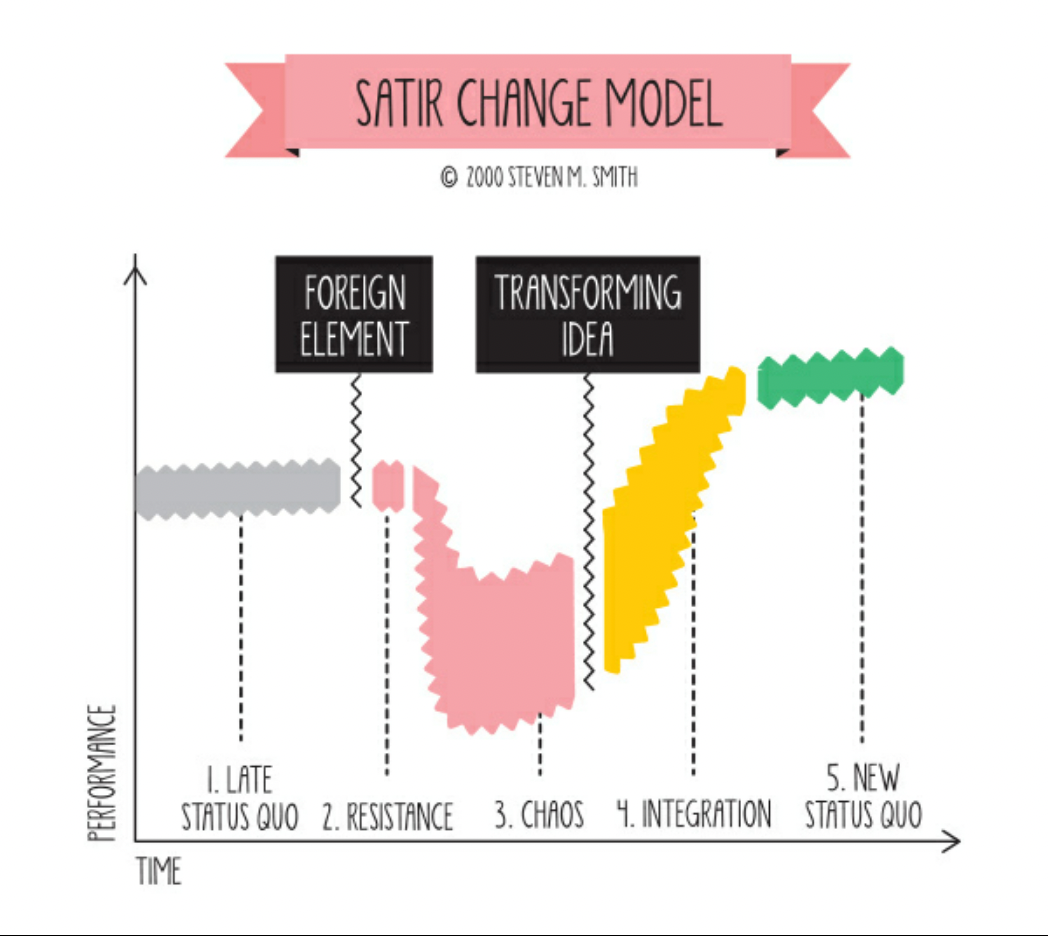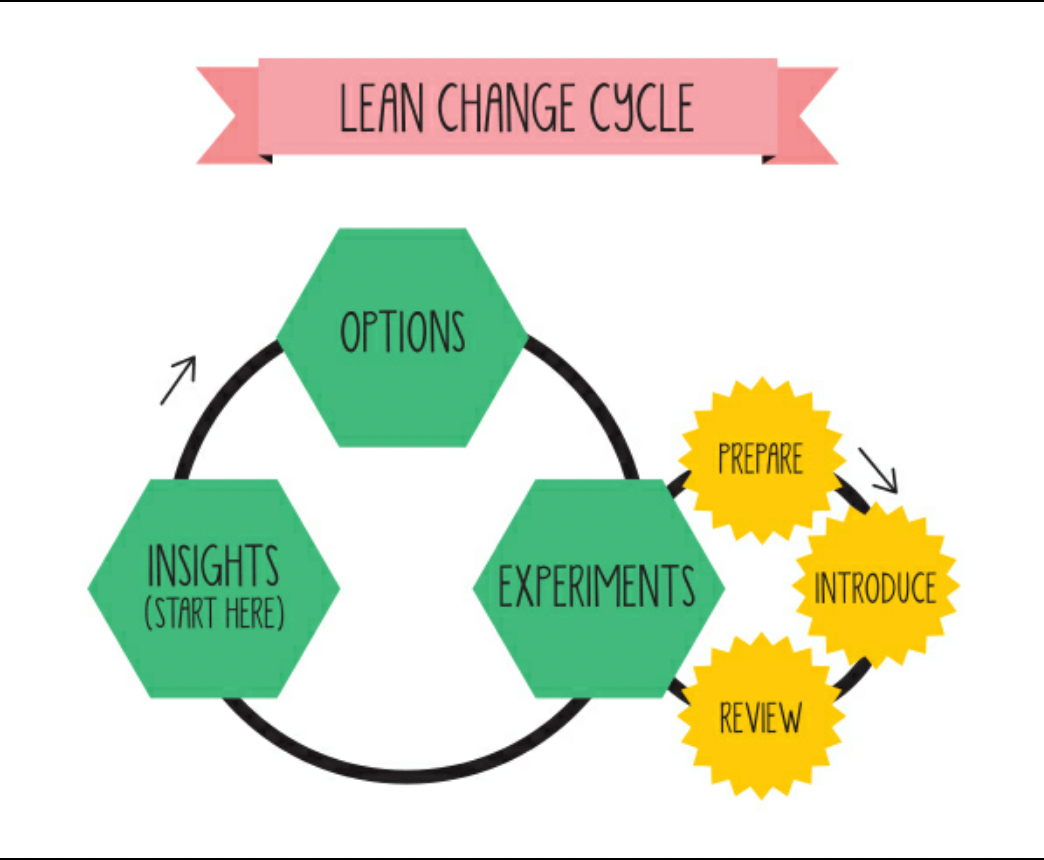Jason’s target audience for Lean Change Management are people passionate about bringing meaningful change into their organisations. Though focussed on change created by Agile practices, ‘change is change’.
Lean Change Management uses a feedback based approach to refine Change Management, having holding an Agile approach to managing change.
Jason introduces us to the concept of change models using the Satir change Model, he reflects on a conference experience in which attendees take each of the five roles in protecting the Star (an attendee selected to be the control item)
 Satir Change Model - Lean Change Management, Jason Little
Satir Change Model - Lean Change Management, Jason Little
- Late Status Quo: The current state, everything is stable and familiar. This group built walls to protect the Star and hold them where they were. Physical and psychological boundaries
- Foreign Element: This is the introduction of change, something new, something that attempts to question the Late Status Quo.
- Chaos: A sense of confusion, lost identity and certainty. This can lead to
- Integration: This is the stage at which people involved in the change ‘get it’, they can see the ‘why’ and explore how it might work
- New Status Quo: The new world, the change is in place and performance is stabilising. If the change was correct and adopted we should be seeing higher performance than at the Late Status Quo stage.
At the end of the exercise, the instructor brought a Speaker the Star (the person representing the thing that was to change) admired. All by themselves the Star left the corner the Late Status Quo were trying to trap them in, and moved to the corner the New Status Quo wanted them to be in.
Jason’s key learning here is: >Change cannot be controlled and People have a way of fighting through change when they want the outcome badly enough.
This reminds me of a great Alan Watts quote on change:
The only way to make sense out of change is to plunge into it, move with it and join the dance.
- Alan Watts
Change Resistance
It’s likely everyone goes through the change response cycle, either as defined by Kubler-Ross or the Satir Change Model. What differs if the cadence or speed at which they go through the stages. It can be momentary, long-lived or something people elect to escape from.
There are a wide range of root causes for resistance to change; person values or need for certainty, not seeing the benefit of the change or through misalignment with their belief system.
Humans are emotional, we are emotional even when we believe we are not. The most Emotionally Intelligent people will understand what is an emotional and what is a logical and considered reaction, however emotional responses are difficult and harmful to suppress long term.
The Lean Change Cycle
 Lean Change Cycle - Lean Change Management, Jason Little
Lean Change Cycle - Lean Change Management, Jason Little
The Lean Change Cycle is a non-linear model that utilises feedback loops for managing change. The model is for managing the change - not the change itself!
- Insights: (Starting point) before instigating change, a good understanding of the current state is needed. Understand the landscape
- Options: What are the potential ways forward? What are the likely impacts, cost and benefits of each option. These options are turned into Experiments.
- Experiments: The introduction of change, each Experiment has sub processes:
- Prepare: Do a light-weight plan for the change, keep it light so it is adaptable, we are making a lot of assumptions at this stage
- Introduce: Work with the people affected by the change. Limit the number of simultaneous changes
- Review: Review the outcomes after the change is implemented, don’t do this too soon. We want to measure the approach is working and allow ‘novelty’ to wear off
Insights
Insight collection can (and should) be done through a variety of methods. Staff interviews, informal meeting or catchups, cultural assessments, surveys and ADKAR are just a few.
To assess what change or projects are in play, create a very visible Enterprise KANBAN Board, use it to ascertain what is actually in-flight, approved, budgeted. The amount of simultaneous can can reduce the organisations capacity for change, you may also find out one department is being continually hammered with change!
From the data collected through these methods, analyse and look for themes and generate options.
A key insight is to start to gain a good understanding of early adopters, change champions, where resistance may reside and the influence of both early adopters and resistance.
Retrospectives
Agile Retrospectives are another technique to gain insights. They are particularly powerful as the occur as change is happening and the transition to new is occurring.
Kurt Lewin Force Field analysis
The social psychologist Kurt Lewin introduced the three-phase journey.
- Unfreeze: unlock the current state.
- Changing: Accept, adjust and transition to future state
- Freezing: lock in the new state, make this the business as usual state
A technique introduced by Lewin is Force Field Analysis. List all the items restraining the change on the right and all the driving forces on the left. Score each item in the range 1 through 5. 1 representing a weak force and 5 representing a strong force. Add up both columns, the column scores the highest is the influencing force on change.

Change Agent or Change Manager Tips
Help those affected by change understand the why and the benefits.
Communicate, communicate, communicate. Stay ahead of the rumours, silence is not the friend of the Change Manager.
Managing resistance is managing perspectives of the individual, the group and the leaders.
Establish and maintain relationships in the organisation and project teams.
Always be on the hunt for feedback, sense confusion, knowledge gaps, gaps in as yet unknown stakeholders.
Jason Little has some amazing resources and a growing community at leanchange.org